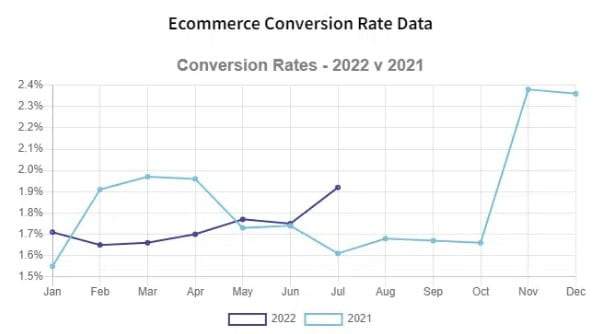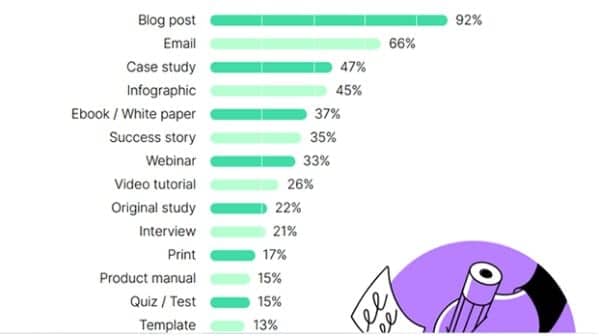The eCommerce industry provides an excellent opportunity for businesses to scale. Experts predict that sales in the global e-commerce market might reach $58.74 trillion by 2028. So if you’re thinking of launching a side business of custom merch using white-label products, your idea has great potential.
However, just like any brick-and-mortar store, it needs compelling marketing to have active and buying customers. Marketing in the context of online stores is the process of increasing brand recognition and sales. One of the toughest challenges of strategizing marketing is the objective to increase the conversion ratio. Because often, even when you drive substantial traffic to your online store, you hardly have a good conversion ratio.
The percentage of visitors to your online business who actually made a purchase is known as the conversion ratio. According to the most recent surveys and research, the average conversion rate for online stores in 2022 is just 3.65%. However, the average increased over the past year, and we can attribute it to the quick adoption of advanced marketing trends by eCommerce businesses worldwide.

- Save
If you have an online store or plan to launch a side business, it is a good idea to keep up with these latest marketing trends and tactics. In this article, you will learn some unique marketing tips that will help you strategize marketing with a focus on spiking the conversion ratio and boosting your revenue. Let’s dive right into it!
Create Landing Pages For Paid Ads
A landing page is a dedicated web page built for the sole purpose of advertising or marketing strategy in digital marketing. It’s the page visitors would be redirected to after clicking on a CTA on an ad or link available on the social media platform or search engine.
Landing pages are distinct from standard web pages since they elicit a specific response from visitors rather than encourage them to explore the page’s content.
Not enough people use landing pages in their marketing tactics; however, stats show that they have the highest conversion ratio of 23%. Increase your conversion rate by utilizing landing pages to collect consumer data for lead generation. The optimal number of sections for a form is three, bearing an estimated average conversion rate of 10%. Email address plus name (7%) and email address plus birthday (5.7%) are the most common combinations.
Use Video Content
More than half of users will watch a product video online before making a purchase, so why not give them what they want? You can discuss your product in much more depth with video content, and it’s a terrific approach to strengthen the understanding of your brand.
Videos cater to the public with a shorter attention span. Short attention spans mean less time to attract customers in a mobile-first environment. And today’s consumers possess shorter attention spans than ever; hence you should utilize video even more.
To make a stronger impression, it is better to show than explain. On average, users stay 2.6 times longer on a website featuring video content, and it brings 66% qualified leads. So start creating video content to enhance your marketing strategy and boost those conversion rates.
Write Useful Blog Content
Most SEM/SEO efforts are built on written content, and blogs have consistently been among the most widely used content formats. With the majority of marketers writing blog entries, it’s clear that they see the value in doing so. You can use blogs to attract new visitors, convert them into leads, and inform and engage current consumers.

- Save
Source: https://bloggingwizard.com/content-marketing-statistics-trends/
Businesses that publish regular blogs get more leads every month, and there is a direct correlation between the length of a blog post and its success. Long-form blog posts with over 3000 words generate 24% greater shares and receive twice as much site traffic.
Use CTAs on Your Website
The last thing you want after investing time, energy, and resources into developing a website to advertise your services and products is for consumers to bounce without purchasing anything. By urging the visitors to take some action, rather than just viewing and abandoning your website, a Call to Action is an easy and efficient strategy to create conversions and eventually enhance revenue.
A website’s Call to Action (CTA) is a command given to the user to prompt them to perform a specific action. The “contact us,” “learn more,” or “subscribe to our weekly newsletter” phrases are all examples of calls to action.
Experts found personalized calls to action have a 202% higher conversion rate. Simply using “submit” as a CTA may not serve the purpose. In fact, using the word “submit” might decrease your chances of conversion. Here are some other phrases that do better than “submit.”

- Save
https://bloggingwizard.com/landing-page-statistics/
Compare Conversions Across Different Channels
It seems logical to focus on the most popular channels since that’s where most consumers are. Still, studies indicate that it requires an average of three or four encounters for consumers to consider interacting with a business.
Users spend about a quarter of their screen time on social networks. The remaining time is divided among email, video streaming, web browsing, gaming, reading weblogs, and possibly working across various devices.
This makes it more challenging than ever to attract the attention of your intended audience. Therefore, more digital marketing channels provide more opportunities to reach consumers and remain top of mind when they’re ready to buy, reducing the risk of losing sales to rivals.
So, how do you do that? A conversion rate optimization (CRO) tool may help. The goal of conversion rate optimization (CRO) software is to enhance conversions by helping you analyze user behavior on your website and test hypotheses for improving the site’s usability.
Use Personalized Marketing Messages
Using personalized marketing messages includes employing analytical methods for tailoring communications and purchases to individual consumers.
Simply addressing each customer by their name in a mass-distributed marketing email is a minimal part of what personalized marketing entails. The key is to send the correct message to the right person at the right time with the appropriate recommendations.
Statistics show almost three-quarters of consumers are frustrated by impersonal shopping experiences. However, a larger number of consumers react to marketing when it is personalized and tailored to their specific interests.
Update Existing Content
For as long as search engine optimization (SEO) has existed, content marketing and SEO have gone hand in hand. Search engine optimization (SEO) is the process of enhancing the discoverability of your material on the web through web crawlers like Google or video hosting sites like YouTube. Marketers often claim that search engine optimization is their most effective content marketing approach that brings in most of the traffic to their website.
However, when it comes to ranking top on search engines, you don’t necessarily need to generate a huge volume of SEO content. Finding time to examine and update your existing material on a regular basis might provide significant benefits. Updating and reusing the current content is an efficient way to save time and resources on marketing while still delivering something fresh to your audience.
In order to increase your content’s visibility in search engine results pages (SERPs), you should revisit the existing content frequently to ensure it still contains relevant information and has not become stale.
Conclusion
A solid conversion rate is the backbone of any eCommerce business. In order to reduce the expense of acquiring new customers, optimizing your conversion rate is crucial. The benefits of digital marketing for an online store’s bottom line are obvious: more customers, more participation, and more money in the till.
You may use the methods we discussed here to create a plan for each source of traffic and monitor the results using marketing dashboards.